Alaska Fish & Wildlife News
May 2015
Detecting Grizzly and Polar Bear Dens
on Alaska's North Slope
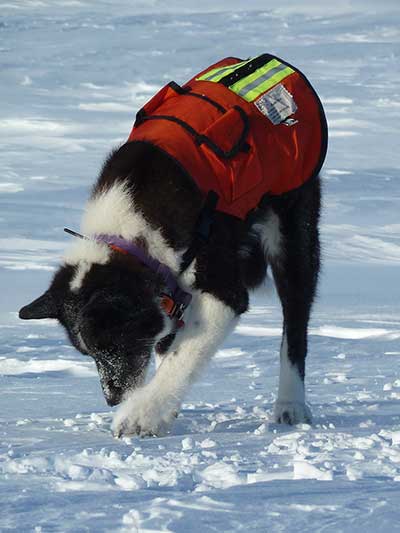
U.S. Fish and Wildlife Service biologist Craig Perham was sitting on his snowmachine taking notes when he was surprised by Karelian Bear Dog, “Kavik,” trotting resolutely by, heading up the nearby slope. Kavik’s owner, ADFG biologist Dick Shideler, had just unloaded him from the Hagglunds tracked vehicle and was preparing Kavik’s work vest when the dog pulled away and took off upwind toward the nearby ridge 300 meters away.
Shideler and Perham were searching for polar bear dens along Alaska’s Beaufort Sea coast. They were accompanied by Karelian Bear Dog “Baloo,” an apprentice den detection dog from the Wind River Bear Institute in Montana and her handler Trent Roussin. Kavik continued upwind and began digging at the top of a hard snowdrift near the crest of the ridge. This was his indicator that a female polar bear and her new cubs were buried deep under the drift in their nearby snow den. Shortly after, Baloo joined Kavik and indicated that she, too, smelled the bears. Shideler marked the location so that he and Perham could return the following summer to inspect the site, and the crew continued on with their den survey.
The incident occurred during a cooperative project between ADF&G and USFWS to investigate methods to detect denning polar bears. A companion study, funded by the National Fish & Wildlife Foundation as part of Shideler’s North Slope oilfield grizzly bear project, investigated methods to detect denning grizzly bears. Both projects were in the region around the North Slope oilfields and were initiated in response to requirements from management agencies that industry avoid denning bears when conducting their off-road exploration and transportation activities. Off-road activities are, for the most part, restricted to winter once the ground is frozen and there is sufficient snow cover to prevent damage from heavy equipment to the tundra. Although exploring for oil and gas during winter reduces tundra damage, it also coincides with both grizzly and polar bear denning. The potential for disturbing denning bears, which could affect their winter survival as well as the safety of workers operating near an occupied den, has prompted agencies to require that winter activities avoid dens.
There is currently no way to predict where dens will be, and they cannot be avoided/protected if their den location is unknown. Especially with polar bears, which excavate maternal dens in snowdrifts along the coast and barrier islands, detection of dens is a high priority because only the pregnant female polar bears excavate dens, and very few of them are radio-collared. The situation is a bit better with grizzly bears because Shideler has had 30-40 bears radio-collared each winter and can usually find about 20-25 dens. However, at some point the grizzly bear study will end and industry will have to rely on other methods to locate dens. This is where the den detection studies come in.
To date, three methods have been tested to detect bear dens: (1) Forward-Looking Infrared (FLIR) imagers mounted on a helicopter or fixed-wing aircraft; (2) a handheld IR camera that takes still images, and (3) scent-trained Wildlife Service dogs like Kavik and Baloo. The two imagers detect wavelengths of light on the surface of the snow that are in the infrared (IR) spectrum invisible to the human eye. However, the sensor mechanisms differ. An airborne imager detects wavelengths within a certain predefined spectral range and displays those as video output in black, white, and shades of gray. We look for bright white objects (“lightbulbs”) indicative of a warm object in a thick band of black indicating a deep drift (pictured below). The handheld camera imager detects different wavelengths of IR, and converts them via a program to display temperature as a shade of color on a digital picture. Unlike the airborne FLIR imager, the handheld thermal camera allows considerable manipulation of the data image in order to enhance the contrast between background and the “hotspot.” We post-process” to improve the contrast. The dog’s “imager” is its trained nose where the stimulation of the millions of sensory cells by airborne molecules given off by the bear allows it to detect faint scent percolating through the snow drift to the surface where it can be carried by the wind. The dog’s handler merely ensures that the dog is in the right position for its “imager” to work. It is somewhat ironic that ultramodern technologies borne of sophisticated engineering and computer science are complemented by an ancient technique that still requires a partnership between dog and man.
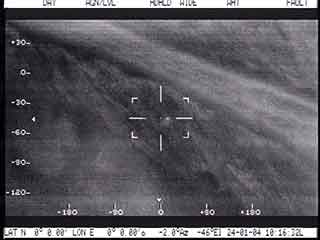
Airborne FLIR was first tested over a decade ago on denned female polar bears by biologists from the U.S. Geological Survey’s Alaska Science Center. The initial results were promising in that most (83 percent) of the known females were detected by the end of the study, but it took up to seven flights to detect some of them. Only 39 percent were detected on the first flight. Nevertheless, the USGS group was able to demonstrate that under certain conditions there was a better than average chance of finding a den. Those conditions included no blowing snow on the surface and no moisture (e.g., fog, ice crystals or suspended snow) in the air that would interfere with the IR signal. Timing of the surveys was also important because the IR sensors are so sensitive that even the pitiful bit of sunlight during the short days in the early Arctic winter can warm the surface enough to fool the sensor and “wash out” the image. Therefore, to be reasonably certain that denning bears would be detected, the flights had to occur on a cold clear “night” during darkness or civil twilight, which on the North Slope occurs for a couple of months straight and fortuitously coincides with the timing of polar bear den construction. USGS also found that if they surveyed within a day or two after a significant storm event they had trouble detecting a denned bear. Again due to sensor sensitivity, the tiny bit of friction created by the wind and warmer new snow generated enough residual surface heat to confuse the detector until the surface cooled down enough to provide contrast between the slightly heated snow surface over the den and the colder surroundings.
Someone familiar with the North Slope might look at these criteria and think that all these conditions are not in perfect alignment very often, and they would be right! Using the criteria developed by USGS, Shideler calculated that in winter 2009-10, a particularly stormy year, there were only nine days in December and January when conditions were optimal for airborne FLIR. From a practical standpoint this means that some if not all FLIR flights will take place when conditions are sub-optimal, and the probability of detecting a denned bear is far from 100 percent. Furthermore, even with perfect conditions there can be errors in interpreting the FLIR image. For one thing, the FLIR sensor doesn’t discriminate between a hotspot that could be a chunk of buried tundra slumped off the bank, a barrel buried under the snow, or a bear tucked away in its den. On any flight there are numerous such hotspots that need to be reviewed and deleted by experienced interpreters who must decide which one is the denning bear. Occasionally there are hotspots that are white “lightbulbs” that even inexperienced viewers would identify as a den. However, the value of the interpreter’s skill comes with an image that catches one’s eye as a light gray anomaly in the right position in the drift for a den. Advances in FLIR technology have taken some of the guesswork out of it, but a skilled interpreter is still a big determinant of success even if the atmospheric conditions are suitable for acquiring a good image. The current FLIR system that industry uses to survey for polar bear dens is state-of-the-art, yet some occupied dens have been missed (called “false negatives”) and some hotspots have been incorrectly identified as dens (called “false positives”). This is no reflection on the FLIR crew at all but suggests that further refinements in den detection methods are needed.
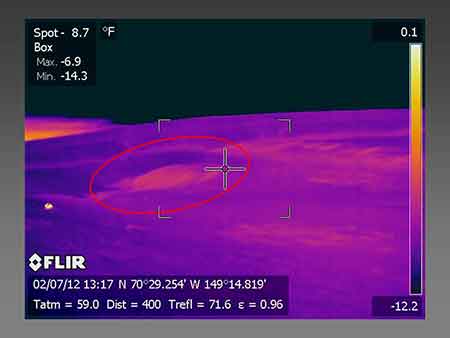
Although airborne FLIR technology has improved, it is expensive, the hardware is somewhat temperamental, and successful application relies on the combination of aircraft and FLIR components to be available during the optimal time for surveying. In an attempt to find a more portable and user-friendly system, Shideler and Perham and USGS colleagues began to test handheld thermal IR cameras. The thermal cameras are the size of old-style camcorders and can be transported on a snowmachine or in a tracked vehicle. There were some early successes with polar bear dens, but also some false negatives. During ADFG’ s “proof of concept” test of the thermal cameras to detect denned grizzly bears, only about 40 percent of the dens were detected even when the radio-collared bear’s den location was known. Part of the problem is that the handheld IR camera is subject to the same atmospheric restrictions as the airborne FLIR, perhaps even more so in the case of blowing surface snow. If there is a small amount of blowing snow on the surface the airborne FLIR is looking through a thin band from above but the handheld IR is at ground level and looking through a much wider expanse. Like eyeballing a stream for fish from a bridge versus looking from stream level where waves and reflection can obscure the lurking lunker. Then too, the maximum distance that an image has been acquired with the IR camera is around 60 meters, so you have to be pretty close to the den to detect it. Handheld IR cameras do have some advantages: they are portable so they can be deployed quickly as soon as conditions improve, and do not rely on a large amount of infrastructure support. As we learn more about their effectiveness under varying conditions and as technology advances, we will likely be able to improve the success of handheld IR cameras, especially for follow-up ground-truthing hotspots previously detected.
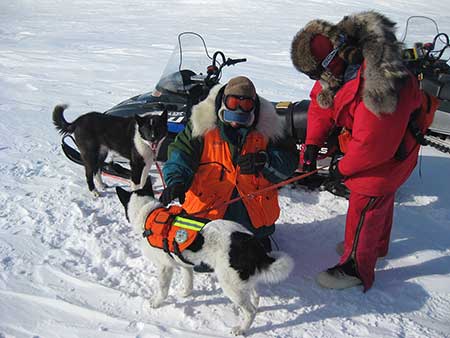
The third technique that Shideler and Perham have tested came about as a happy coincidence. Shideler had been using his Karelian Bear Dogs, Riley and Kavik, for bear conflict work in the oilfields. Mostly as an informal experiment, he began taking them out to dens of radio-collared grizzly bears to see if the dogs could find them. He continued to do this on an informal basis when grizzly bears denned near the oilfield road system so he could reach them on foot or with a borrowed snowmachine. One day Perham and Shideler, as dog aficionados often do, started discussing their experiences with dogs on the North Slope. Perham had been currently working with trained Labrador Retrievers to find seal lairs and breathing holes as part of a project to reduce impacts of offshore ice roads on seals. He and his colleagues had also conducted a pilot study to find out if the same dogs could find polar bear dens. They found that not only could the dogs confirm that hotspots detected by the airborne FLIR were indeed dens (i.e., true positives), but the dogs also located a den that the FLIR had missed.
Based on their joint experience, Shideler and Perham developed a collaborative study funded by a USFWS State Wildlife Grant to ADFG to investigate methods to detect polar bear dens. Concurrently, Shideler expanded the grizzly bear study to more formally investigate methods, including dogs, to detect grizzly bear dens. They developed a set of procedures for using the dogs that would maximize human and dog safety and minimize bear disturbance. Using Shideler’s Karelians Bear Dogs (pictured) and, later, apprentice dogs like Baloo from the Wind River Bear Institute, they found that dogs not only confirmed hotspots as dens (i.e., true positives), but also detected dens the airborne FLIR missed. Not that the dogs were perfect, but they successfully detected about 95 percent of the grizzly bear dens and 75 percent of the polar bear dens in weather that would have grounded either IR method.
The dogs missed a couple of the polar bear dens on the same day when the temperature was -35° to -40°. The humidity at those temperatures is very low and Shideler speculates that the low humidity interfered with the dogs’ ability to scent, where there may be a lower humidity threshold at which dogs cannot detect dens. Dogs need to keep their nasal sensory receptor cells moist in order for them to be stimulated by the molecules of scent that are dissolved in moisture in the air. Although dogs are not the perfect “imagers” either, one advantage of dogs is that they did not alert on anything that was not a den, i.e., they did not produce false positives. Although not as important as a false negative (i.e., missing a den), eliminating false positives is important because it is expensive for industry to reroute an ice road or a seismic line around a potential den, and if no den is actually there then the reroute has cost a great deal with no conservation benefit.
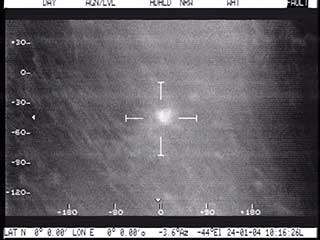
There appears to be no “silver bullet” that will provide the perfect method to detect bear dens on the North Slope. Each method tested so far comes with its own list of advantages and disadvantages. Airborne FLIR can survey long distances over a short period of time; however, limitations on availability and rapid response to optimal conditions suggest that the technique may need to be supplemented with other methods. Furthermore, more testing has to be done on grizzly bear dens to flesh out ways to optimize surveys for their dens. The future of airborne FLIR may lie with Unmanned Aerial Vehicles (UAV’s—“drones”). If the FLIR sensors on UAV’s prove successful in detecting denned bears, their relatively low cost, portability, and potential for rapid deployment may make UAV’s the “next big thing” for aerial FLIR operations. The University of Alaska-Fairbanks is beginning to investigate that the efficacy of UAVs, and both Shideler and Perham are advising on the project. Handheld IR imagers will continue to have a niche, especially since the industry airborne FLIR system is not currently available to all companies operating in the oilfields. However, the short range at which IR imagers are effective will probably limit their use to spot-checking or short-distance surveys.
Trained scent dogs have proven their effectiveness for detecting both grizzly and polar bear dens. Although Shideler and Perham have surveyed tens of kilometers of polar bear habitat in a day, dogs can become fatigued or injured and their effectiveness reduced. Their utility for surveying a 100-km long ice road or seismic line is possible but would take several days as opposed to a few hours of airborne FLIR. In addition, the availability of dogs trained to find bear dens is a limitation. However, dogs have the highest success rates in finding dens and are worth considering, especially to ground-truth potential hotspots detected by other means. And most notably, they will not alert on a non-existent den. An integrated approach to bear den detection will probably yield the best success in locating dens and reducing encroachment by winter industrial activities.
And what about the polar bear den that Kavik and Baloo found? Colleagues from Brigham Young University had set up a remote camera to capture den emergence behavior on the west side of the same mound because polar bears had previously denned there. Although an airborne FLIR survey had not found any bears denned on either side, after the dogs alerted on the east side BYU moved their camera to the new spot. A few weeks later they were rewarded with footage of the family group exiting the den and the cubs playing around it. Unfortunately, they also captured footage of a large nose on their lens followed by black as the bear trashed their camera setup. Nevertheless, the dogs alert had been confirmed—a true positive.
Dick Shideler is a state wildlife biologist based in Fairbanks.
Subscribe to be notified about new issues
Receive a monthly notice about new issues and articles.
